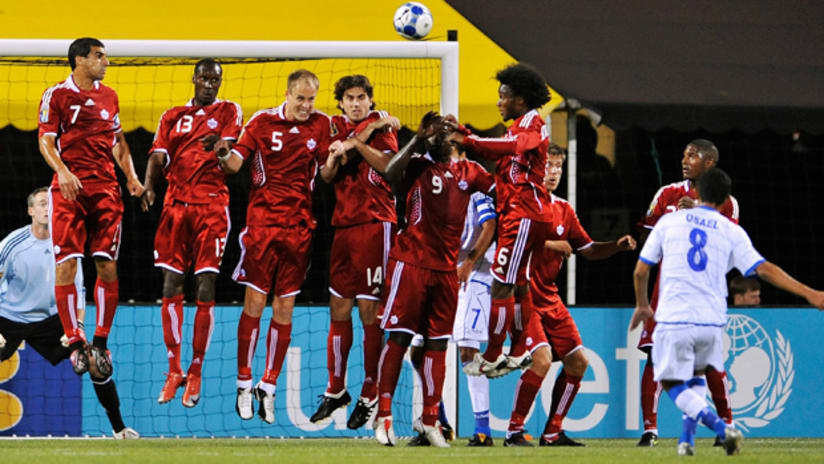In the not too distant past, pioneers on both sides of the U.S.-Canadian border headed west for riches and fame. For the future development of Canadian men’s soccer at the highest level, the saying now goes, “Go east, young man!”
Just weeks after winning the bid to host MLS Cup 2010, Toronto now appears poised to once again be the focal point for the Canadian men’s national team.
On Friday, the Canadian Soccer Association announced the remaining 2010 schedule for the team at Toronto’s BMO Field, highlighted by home matches at BMO Field and Stade Saputo in Montreal, the two lone soccer-specific natural grass stadiums in the country.
Canada will face an undisclosed opponent in Toronto on Sept. 4 before traveling to Montreal for a CONCACAF Gold Cup 2009 quarterfinal rematch against Honduras on Sept. 7. The away matches see Canada at Venezuela on May 29 and a first-ever encounter in Ukraine with the UEFA Euro 2012 co-host on Oct. 12.
The news marks a shift in the balance of soccer power from west to east.
Throughout the 1990s and much of the last decade, the CSA played most of its key matches -- World Cup qualifiers -- in either Edmonton or Vancouver. Toronto was virtually bypassed by the CSA due to the lack of a proper stadium.
But times have changed. Since the opening of BMO Field in 2007, the city has hosted matches for FIFA U-20 World Cup Canada 2007, the MLS All Star Game, a FIFA World Cup qualifier, a Real Madrid exhibition match and a number of international friendlies.
Interestingly, BMO Field had the official moniker of the “National Soccer Stadium” during the U-20 World Cup due to corporate-partnership rights issues.
Only now is the stadium beginning to live up to that claim, and have one thing to thank: natural grass.
Citing a lack of interest from players and international clubs in playing on FieldTurf, Toronto FC parent company Maple Leaf Sports and Entertainment recently installed a natural grass pitch at a cost of $5 million.
For the last three years, BMO Field’s synthetic grass has been an obstacle in the CSA’s efforts to host friendlies. With real grass, the CSA hopes to not only increase the number of matches, but also the caliber of opponents, recognizing that the national team will achieve its goal of qualifying for the 2014 World Cup if it plays top level opposition.
“Playing quality opposition is the only way to raise standards,” said Canadian national-team manager Stephen Hart. “The games will allow staff the best possible opportunity to evaluate players. By the same token, it will allow players to test themselves.”
The new grass and the existence of Stade Saputo, combined with the conversion of Edmonton’s Commonwealth Stadium to synthetic grass, signals the rise of Canada’s two largest cities as sites of the most significant national team matches in the next few years. Going even further, CSA general secretary Peter Montopoli didn’t rule out the possibility of Toronto hosting a future group in the Gold Cup.
Though Vancouver’s Swangard Stadium is grass, its smallish capacity (less than 7,000) doesn’t make it a viable venue. A temporary stadium is being constructed for the Vancouver Whitecaps’ inaugural 2011 season in MLS, before the club moves into a refurbished B.C. Place, but both stadiums are synthetic grass despite being designed with soccer in mind.
“The No. 1 requirement is grass,” said Montopoli. “If Edmonton is going to turf, then there’s less likelihood of it hosting matches, although its FIFA two-star turf is a quality surface. Toronto and Montreal are the focus, but there could be more availability [to host matches elsewhere] on the women’s side.”
Though manager Stephen Hart has said he doesn’t care where the team plays, focusing on Toronto and Montreal makes good business sense. Both cities have sizeable corporate bases, are the headquarters of the country’s major media outlets and possess large and passionate soccer fan bases.
This is critical from the standpoint of generating greater revenue, the lack of which has hamstrung the CSA and the development of its national teams for many years. That requires a long-term solution.
In the interim, a positive sign is Canada’s growing appetite for soccer. To date, Canadians have purchased more than 16,000 tickets to this summer’s FIFA World Cup, the highest among non-participating nations, positioning it fifth overall.
The CSA hopes its home matches will harness that interest and raise the profile of the men’s national team throughout the country.
The team’s absence from the country’s two largest markets perpetuated an “out of sight, out of mind” effect for the profile of the national team. Considering that some casual soccer fans surveyed still question whether Canada even has a national team, the shift is a welcome one.












